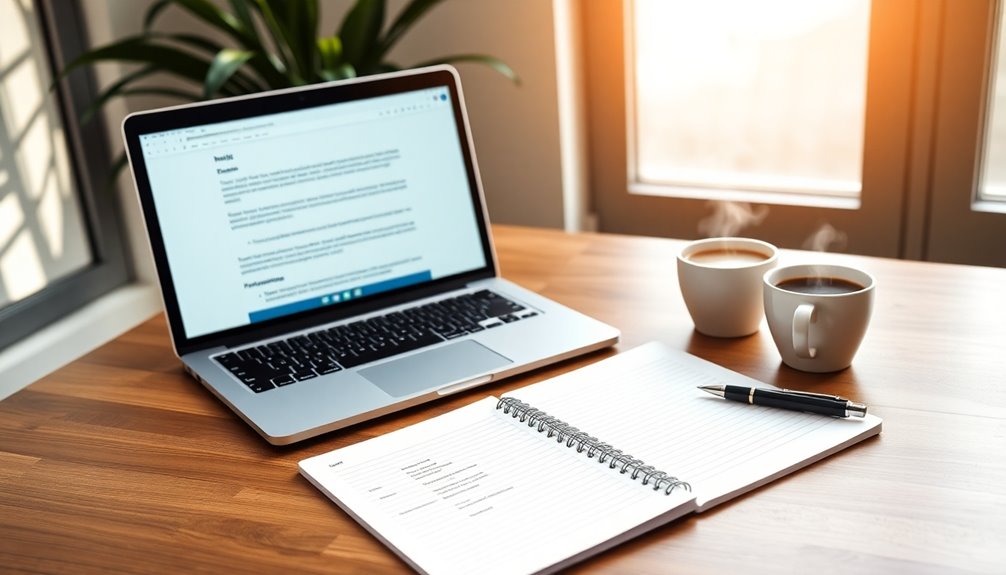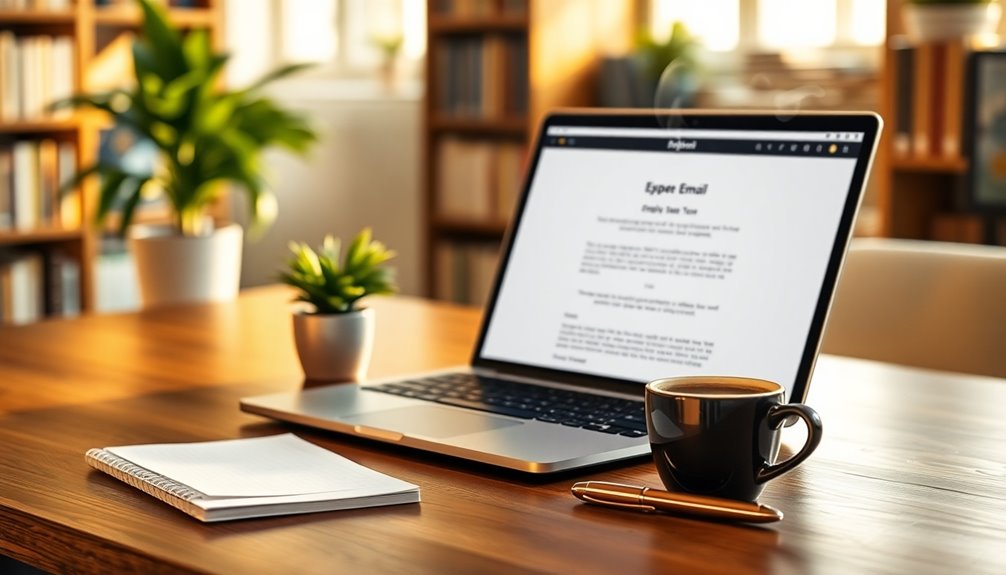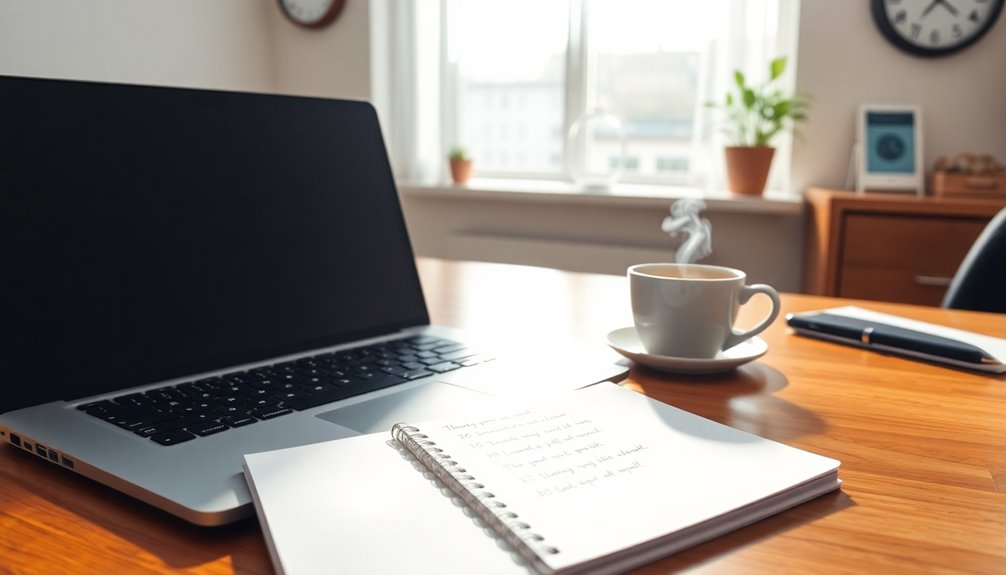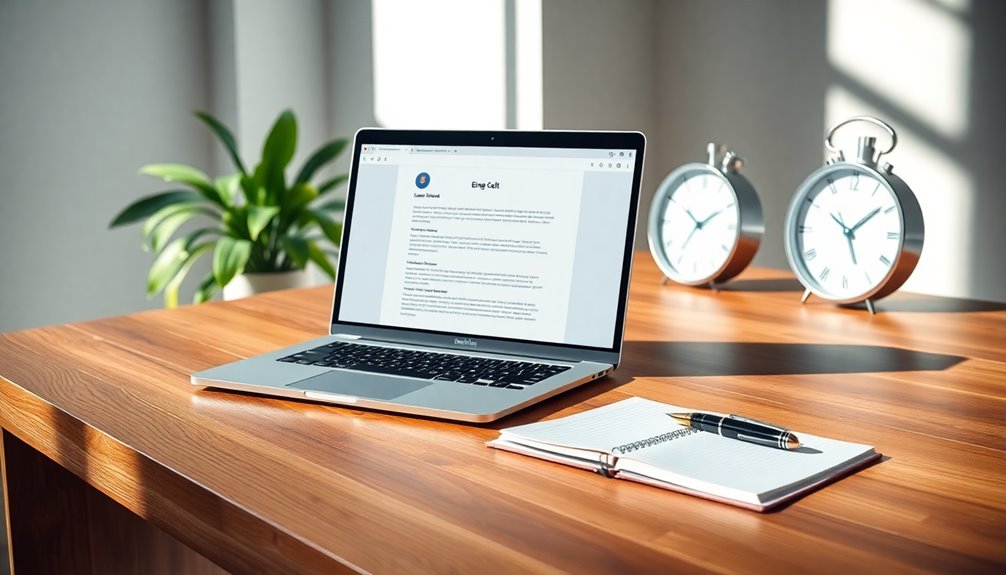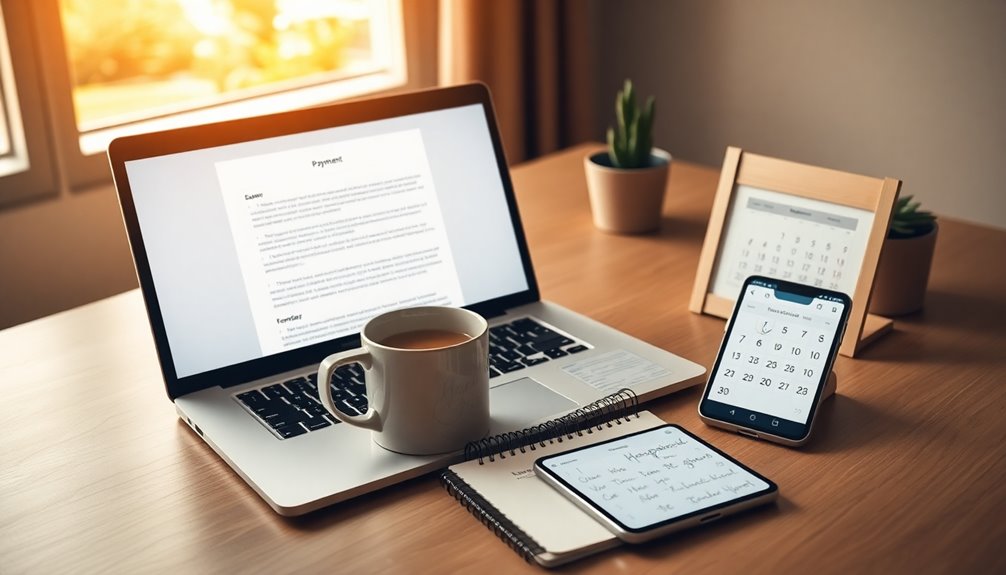To write a perfect professional email every time, start with a concise subject line. Use a formal greeting that addresses the recipient respectfully. Organize your thoughts clearly, using short paragraphs or bullet points for easy reading. Incorporate a clear call to action, guiding the recipient on what to do next. Always show gratitude, especially in follow-up and thank-you emails, as this strengthens relationships. Don't forget to proofread your email for errors. By following these steps, you'll enhance your professional image and communication skills. There's more to explore on crafting impactful emails effectively.
Key Takeaways
- Start with a clear, concise subject line under 60 characters to set expectations and enhance open rates.
- Use a formal greeting that includes the recipient's name and title to establish professionalism.
- Organize your email with short paragraphs or bullet points for improved readability and comprehension.
- Include a clear call to action to guide the recipient on the next steps you desire.
- Personalize your message and express gratitude to strengthen relationships and encourage timely responses.
Introduction
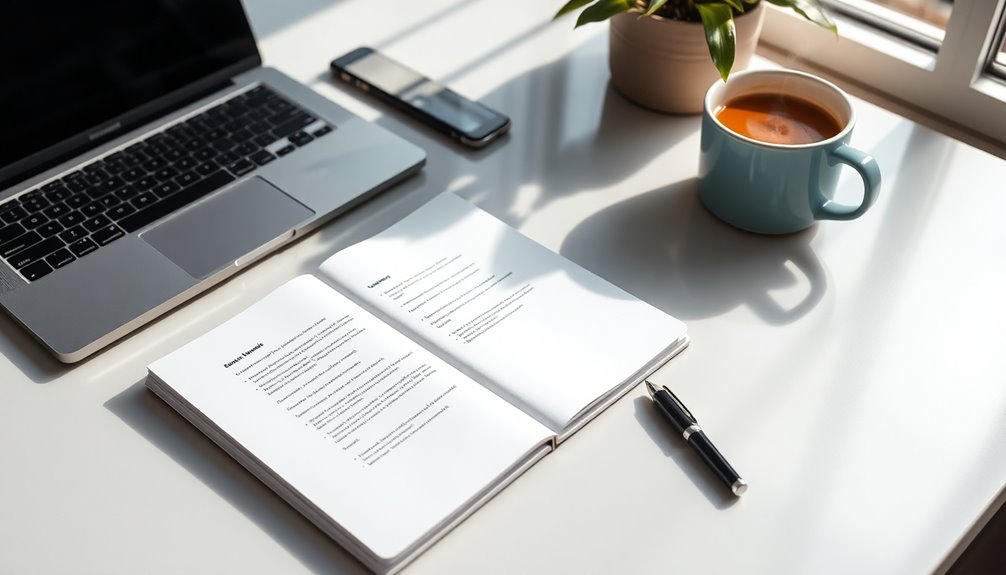
Writing a professional email is crucial for effective communication in today's fast-paced world. When you write an email, you want to ensure it captures attention and conveys your message clearly. Start with a concise subject line, ideally under 60 characters, that reflects the email's content. This sets the tone and encourages higher open rates.
In your email, begin with a formal greeting to establish professionalism. The body of your email should be well-organized, using bullet points and short paragraphs to enhance readability. This helps your recipient quickly grasp the main message.
You might consider including a thank you email for previous interactions if applicable, as this demonstrates good email etiquette.
Don't forget to end your email with a polite closing and your signature. A clear call to action is essential; it reinforces what you want the recipient to do next, whether it's to respond, schedule a meeting, or provide feedback. Additionally, ensuring your email has high-quality content can enhance its credibility and trustworthiness, making it more likely to receive a positive response.
Builds Professional Relationships Quickly
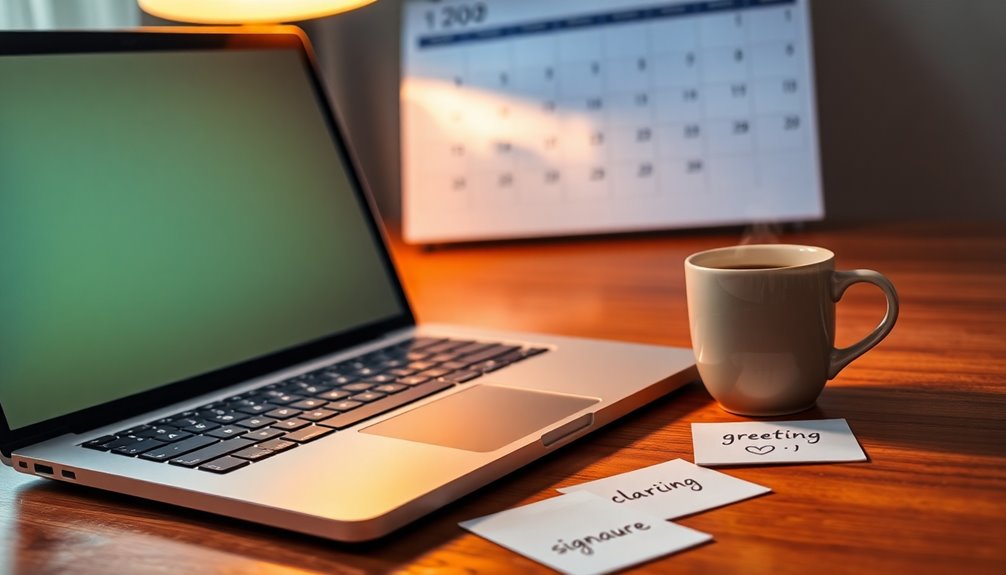
Establishing strong professional relationships can happen quickly through the use of well-crafted emails. When you send professional emails, especially during a job application process, you not only share your qualifications but also communicate your respect for the recipient's time. A clear and concise email format enhances your credibility and fosters trust, which is essential for building connections.
Don't underestimate the power of gratitude. A simple "Thank you for your consideration" or acknowledging a colleague's effort in your follow-up email can strengthen your relationship, as 70% of professionals appreciate such acknowledgment. Your email demonstrates your professionalism and attentiveness.
Moreover, incorporating a call to action encourages recipients to engage with your emails, prompting them to respond or take the next steps. Whether you're asking for a meeting or seeking feedback, this engagement is vital in professional networking.
Lastly, timely follow-ups show your dedication and interest. Studies reveal that prompt responses can enhance relationship-building by up to 40%. Additionally, utilizing accountability partners can further strengthen your networking efforts by providing support and encouragement in your professional journey.
Clear Call to Action
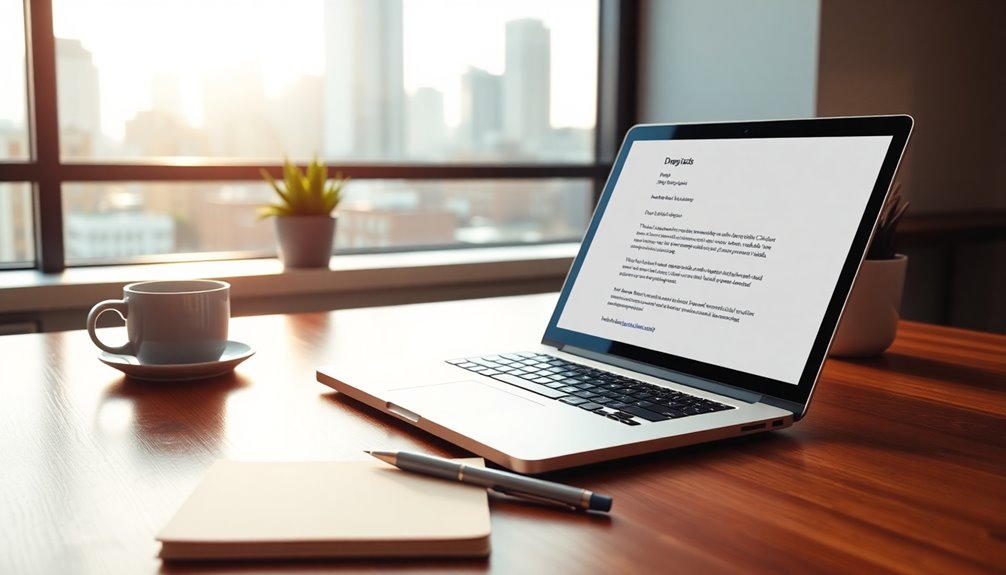
A clear call to action (CTA) can make all the difference in your professional emails. It directs the recipient on the next steps to take, increasing the likelihood of a timely response or desired outcome.
When composing an email, be sure to use action-oriented language. Phrases like "Please confirm your attendance by Friday" or "Let me know your thoughts on this proposal by next week" are effective examples.
Position the CTA prominently within the email message, ideally at the end, so it stands out after the main content.
Best practices also suggest tailoring your CTA to the recipient's context. Make it specific, relevant, and achievable to enhance engagement. This personal touch not only shows you value their input but also encourages a quicker response.
Step-by-Step Guide for Follow-Up Emails
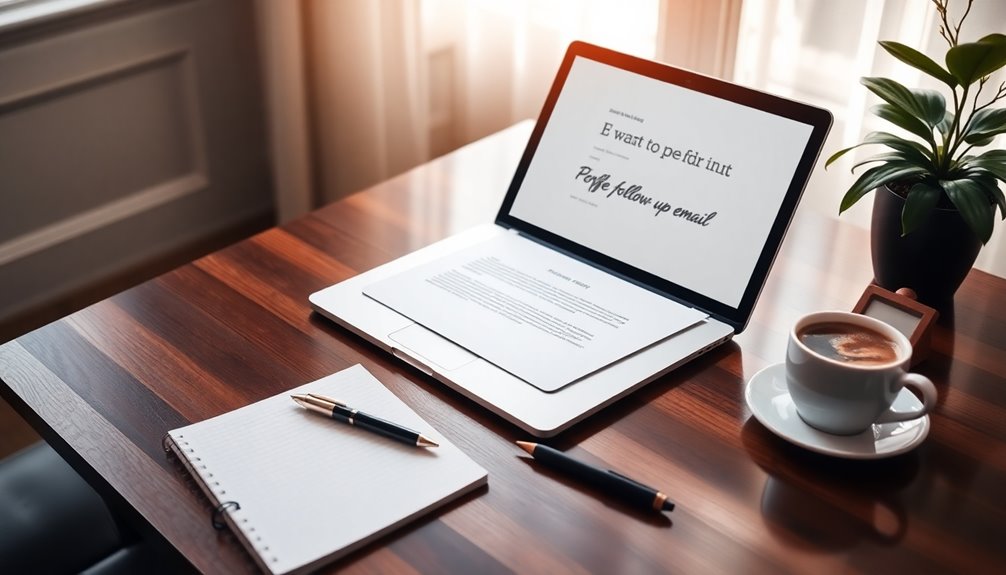
Following up after a conversation or meeting is crucial for maintaining professional relationships and ensuring important discussions don't slip through the cracks. Start your follow-up email by referencing the previous conversation to provide context. A clear subject line, such as "Following Up on Our Previous Discussion," helps the recipient quickly identify the email's relevance.
Next, keep your email concise and focused. Restate key points or questions to remind the recipient of the discussion and clarify your intent. This makes it easier for them to respond. Use a polite and appreciative tone throughout your message; for instance, you might say, "Thank you for your time" in your opening lines. Additionally, be mindful of the importance of effective communication in establishing rapport and enhancing collaboration.
Don't forget to suggest actionable next steps. Indicate what you hope to achieve from the follow-up, whether it's a decision, feedback, or scheduling another meeting. Offering a timeline for a response can guide the recipient on how to proceed, ensuring you both stay aligned. Additionally, consider tracking your follow-up effectiveness using detailed analytics to refine your future communication strategies.
Dos and Don'ts for Thank You Emails

Crafting a thank you email can significantly strengthen your professional relationships. Start by personalizing your message; always address the recipient by name and mention specific actions they took that you appreciate. This little touch makes your thank you email more meaningful.
Be timely—send your email within 24-48 hours after the interaction. Promptness shows you value their effort and keeps the connection fresh. Aim to keep it concise; express your gratitude clearly without overwhelming the recipient with unnecessary details.
Don't forget to include a future engagement. Mention your willingness to reciprocate their kindness or suggest a future meeting or collaboration, which fosters ongoing communication. This not only strengthens your bond but also opens the door for future opportunities.
Lastly, proofreading is crucial. Ensure your thank you email is free of spelling and grammatical errors. A polished, professional email reflects your attention to detail and professionalism.
You can use email templates for structure, but always adapt them to fit your unique voice and the specific situation. With these dos and don'ts, your thank you emails will leave a lasting, positive impression.
Examples of Networking Emails

Networking emails can open doors to new opportunities and professional relationships. When creating a professional email, start with a clear subject line that reflects your purpose, like "Great to Connect!" or "Seeking Career Advice." This helps capture the recipient's attention right away.
Introduce yourself clearly, including relevant background information and professional interests. You might say, "Hi [Name], I'm [Your Name], and I'm a [Your Position] at [Your Company]. I know we share an interest in [Shared Interest] through [Mutual Connection]." Adding this personal touch can increase your chances of a positive response. Additionally, mentioning how automation in your industry is evolving can provide context for your conversation, as many sectors are seeing advancements in automation technologies. Being aware of small mistakes in communication can also help you refine your approach and enhance your networking effectiveness. Regularly reviewing and adjusting your communication strategy can be beneficial for maintaining strong professional relationships, especially when considering retirement savings plans. Furthermore, engaging in audience engagement strategies can lead to more meaningful connections during networking. Exploring top platforms for freelance work may also provide additional avenues for networking opportunities.
Next, make a specific request, like asking for a brief meeting or some advice. For example, "I'd love to please find 20 minutes to chat and gain your insights on [Topic]." This encourages engagement and facilitates further conversation.
Pro Tips for Writing Effective Emails

Writing effective emails can significantly enhance your communication skills and professional image. When you're applying for a job or reaching out to a hiring manager, using a clear and concise subject line is crucial. Aim for 50 characters or less to reflect the email's content and set expectations.
Start your formal email with a professional greeting, addressing the recipient by name and title if applicable. This establishes respect from the get-go.
Structure your email body with short paragraphs or bullet points for better readability. This makes it easier for the recipient to grasp your key messages quickly.
If you're writing to express interest in a role or to submit a cover letter, clarity is key. Always include a call to action in your closing remarks, stating what you expect from the recipient—whether it's a response, confirmation, or additional information.
Final Thoughts

In the realm of professional communication, mastering the art of email is essential for success. A clear and concise subject line sets the tone for your message and significantly influences whether your email gets opened.
When crafting your professional email, structure it with a professional greeting, a well-organized body, and a polite closing to enhance readability. Additionally, understanding the importance of user privacy can further improve how you approach email communication. Just like in legal matters, being aware of filial responsibility can guide how you communicate with family members regarding sensitive topics. Implementing on-page SEO techniques can also enhance your online presence, making your emails more effective. Using necessary cookies on your website can help in providing a secure and functional experience for your recipients.
Don't underestimate the power of personalization. When you personalize your emails, you increase your chances of receiving a response, making recipients feel valued.
Always proofread your email before hitting send—grammatical or spelling errors can undermine your professionalism and credibility.
Finally, ensure your professional email signature includes your full name, title, company, and contact information. This reinforces your identity and facilitates easy communication. Additionally, understanding user consent regarding email tracking can help you maintain transparency and build trust with your recipients.
Whether you're following up on a job or considering my application, a polished email can make all the difference.
Frequently Asked Questions
How to Write a Perfect Professional Email?
To write a perfect professional email, start with a clear subject line that reflects your message.
Use a respectful greeting, and keep your body structured with short paragraphs or bullet points for easy reading.
Be concise and direct, highlighting key points.
Don't forget to include a polite closing remark with a call to action, encouraging a response.
Lastly, always proofread for errors to maintain professionalism and clarity in your communication.
What Is a Good Example of a Professional Email?
A good example of a professional email starts with a clear subject line, like "Meeting Request for Project Update."
You'd greet the recipient formally, saying, "Dear [Recipient’s Name]," followed by a concise introduction.
Organize the body into short paragraphs, focusing on your main point.
Conclude with a courteous remark, and sign off professionally with "Best regards."
Don't forget to include your full name, title, and contact details in your signature.
What Email Address Looks Most Professional?
The most professional email address uses a custom domain that reflects your brand, like yourname@yourcompany.com. This approach enhances your credibility and makes it easier for recipients to recognize you.
Avoid generic services like Gmail or Yahoo, as they can diminish your professional image. Instead, consider creating a unique address, such as john@johnsdesigns.com, and ensure it includes your first and last name for clarity and easy identification.
Regularly update it as needed.
How Do You Start a Professional Sounding Email?
To start a professional-sounding email, kick off with a clear subject line that reflects your message's purpose.
Use a respectful greeting, like "Dear [Recipient’s Name]," to set the right tone.
Then, briefly introduce yourself if necessary, providing context.
Get straight to the point within the first few sentences, clearly stating your main request or point.
Maintain a polite and professional tone throughout to reinforce your credibility and ensure effective communication.
